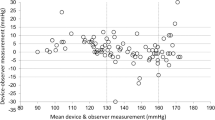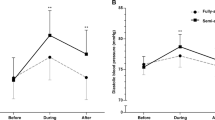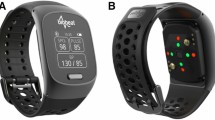Abstract
Despite widespread use of the automatic blood pressure (BP) measuring device OMRON M4, there is little formal validation on its accuracy. A study was conducted to assess the accuracy of the OMRON M4 compared with the true indirect BP measured by mercury sphygmomanometer (MS). A rapid method for the evaluation of automatic blood pressure measurement devices (READ) was applied for this study. The READ is based on numerous BP measurements at rest and during a standardised postural challenge in a small number of subjects who exhibit a wide range of BPs. Blood pressure measurements were done in supine position for 10 min followed by head-up tilt for 30 min and again supine for 10 min. The automatic device (AU) and the MS were connected to one arm-cuff by means of a T connector. A stethoscope with dual sets of ear-pieces was used for duplicate MS measurements (MS1 and MS2). The MS1, MS2 and AU measurements were taken simultaneously in a blinded manner. Three units of the automatic instrument were evaluated. An average of 111 measurements per unit were performed, every BP category being present in ⩾15 MS measurements. The differences between MS1 and MS2 measurements (ΔBP: MS1–MS2) were utilized to assess the consistency of true indirect BP and the differences between AU and MS measurements (ΔBP:AU-MS2) were utilized to assess the accuracy of the AU. The following characteristics of the OMRON M4 were assessed: (1) grade of accuracy, (2) aberration pattern, (3) consistency of the aberration-pattern, and (4) correlation between levels of BP and ΔBP: AU-MS. For MS paired readings, 92–100% of systolic and 99–100% of diastolic readings fell within 5 mm Hg difference range, that is consistent with a British Hypertension Society grade A of both. For AU compared to MS2, 29–64% of systolic and 73–94% of diastolic readings fell within 5 mm Hg and 49–86% of systolic and 86–99% of diastolic readings fell within 10 mm Hg and the devices qualified C, D and C, respectively. All devices exhibited irregular and inconsistent aberration patterns, making the design of correction formulas impractical. In conclusion, the OMRON M4 device did not meet the requirements of the British Hypertension Society and, therefore, cannot be recommended for clinical use.
This is a preview of subscription content, access via your institution
Access options
Subscribe to this journal
Receive 12 digital issues and online access to articles
$119.00 per year
only $9.92 per issue
Buy this article
- Purchase on Springer Link
- Instant access to full article PDF
Prices may be subject to local taxes which are calculated during checkout
Similar content being viewed by others
Author information
Authors and Affiliations
Rights and permissions
About this article
Cite this article
Naschitz, J., Loewenstein, L., Lewis, R. et al. Accuracy of the OMRON M4 automatic blood pressure measuring device. J Hum Hypertens 14, 423–427 (2000). https://doi.org/10.1038/sj.jhh.1001040
Received:
Revised:
Accepted:
Published:
Issue Date:
DOI: https://doi.org/10.1038/sj.jhh.1001040



